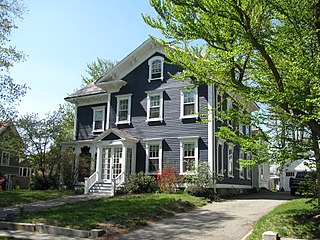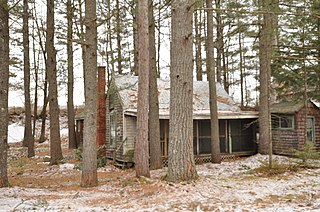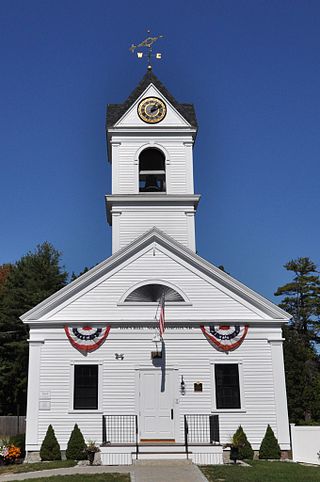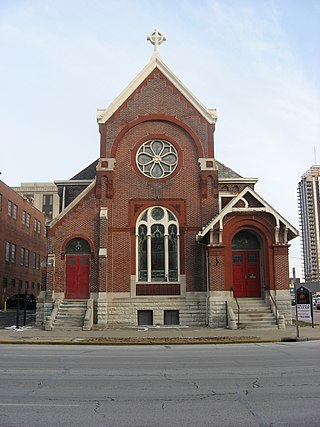
The Potter–Collyer House is a historic house at 67 Cedar Street in Pawtucket, Rhode Island. The house, first constructed in 1863, is representative of vernacular architecture of the Pawtucket due to the great modifications to the home which has obscured the original structure of the home. Believed to have begun as a 1+1⁄2-story cottage with a gable roof, subsequent additions and expansions have added a two-story hip-roof addition and greatly altered the floor plan due to enlargement and remodeling. The Potter–Collyer House was added to the National Register of Historic Places in 1983.

The Thomas S. Sprague House was a private residence located at 80 West Palmer Avenue in Midtown Detroit, Michigan. It was listed on the National Register of Historic Places in 1986, but was subsequently demolished.

The House at 23 Avon Street in Wakefield, Massachusetts is one of the town's finest examples of Italianate. It was built about 1855, and was listed on the National Register of Historic Places in 1989.

The Old Federal Building in Anchorage, Alaska is a structure serving primarily as a courthouse of the United States District Court for the District of Alaska. Completed in stages from 1939 to 1941, the building was listed in the National Register of Historic Places in 1978.

The Willimantic Freight House and Office is a historic railroad freight facility on Bridge Street in the Willimantic section of Windham, Connecticut. Built in 1870, the freight office, a fine example of Second Empire architecture, is now the only surviving element of the city's 19th-century railroad buildings; the freight house has been demolished. The buildings were listed on the National Register of Historic Places in 1982 as an important reminder of the city's importance as a major railroad junction in eastern Connecticut.

Alaska Central Railroad Tunnel No. 1, also known as the Loop District Tunnel No. 1 is a historic railroad tunnel located about 40 miles (64 km) north of Seward, Alaska, in the Placer River Valley, Kenai Peninsula. The tunnel was dug in 1906 and served the Alaska Central Railroad and later the Alaska Railroad until the route in the area, known as the "Loop District" was rerouted in 1951.

The Portland Railroad Company Substation, now the Scarborough Historical Museum, is a former power substation of the Portland Railroad Company, a trolley service provider, at 649 United States Route 1 in Scarborough, Maine. The station was built in 1911, and is one of the few trolley-related facilities surviving in the state. The building was listed on the National Register of Historic Places on March 22, 1991.

The Alaskan Engineering Commission (AEC) was a U.S. Federal agency, sometimes known by its initials or by alternate spelling Alaska Engineering Commission. It was created by the Alaska Railroad Act in 1914 by U.S. President Woodrow Wilson in order to arrange for the construction of a railway system in Alaska. William C. Edes was named chairman, chief engineer Colonel Frederick Mears. In 1915, the AEC became part of the U.S. Department of the Interior. In 1923, after the railroad began operation and construction was complete, it became the Alaska Railroad Commission, later renamed to The Alaska Railroad.
The Whitney Section House, also known as Whitney Station, is a historic railroad-related building in Wasilla, Alaska. It is a single-story wood-frame structure, which was built in 1917 by the Alaska Railroad. It originally stood at mile 119.1, about 4.8 miles (7.7 km) north of Anchorage Station, and was one of a series built by the railroad and located at roughly ten-mile intervals. The area where it stood was taken by the federal government for Elmendorf Air Force Base, and was rescued from demolition by the local chapter of the National Railroad Historical Society. It now stands on the grounds of the Alaska Museum of Transportation and Industry in Wasilla, and has seen a variety of uses.

The Rufus Piper Homestead is a historic house on Pierce Road in Dublin, New Hampshire. The house is a well-preserved typical New England multi-section farmhouse, joining a main house block to a barn. The oldest portion of the house is one of the 1+1⁄2-story ells, a Cape style house which was built c. 1817 by Rufus Piper, who was active in town affairs for many years. The house was listed on the National Register of Historic Places in 1983. The home of Rufus Piper's father, the Solomon Piper Farm, also still stands and is also listed on the National Register of Historic Places.

The Stationmaster's House is a historic house on Jaquith Road in Harrisville, New Hampshire. Built in 1896, it is one of the few surviving elements of the town's historic railroad infrastructure. The house was listed on the National Register of Historic Places in 1988.

The North Hampton Town Hall is located at 231 Atlantic Avenue in North Hampton, New Hampshire. Built in 1844, it was the town's first purpose-built municipal building, and continues to be used as such. Its construction includes materials recovered from older dual-purpose religious and civic buildings, and its tower houses a Revere bell. The building was listed on the National Register of Historic Places in 2013, and the New Hampshire State Register of Historic Places in 2006.

The Juneau-Douglas City Museum is located at the corner of 4th and Main, opposite the Alaska State Capitol in Juneau, Alaska. It occupies a building which was built in 1950–51 to house the Juneau Memorial Library. It is a two-story Classical Revival structure built out of concrete with red marble trim elements. A gable-roofed projecting section at the center of the long wall provides the main entrance, which is recessed in an opening the full height to the pediment. This projecting section is flanked by banks of five metal-framed awning windows. The northeast facade has a gable pediment similar to that of the entry projection, below which is a large rectangular window, behind which a stained glass decoration has been installed. The building served the city as its library until the 1980s, at which time it was repurposed to house the city museum.
The Copper River and Northwestern Railway Bunkhouse and Messhouse are historic railroad worker facilities on Third Street in Chitina, Alaska. The messhouse is a single-story wood-frame structure with a hip roof, measuring 26 by 30 feet. It has a porch on the east side, and a timber-braced entrance on the west side leading to a root cellar under the building. The bunkhouse is also a single-story structure, measuring 43 by 25 feet. It has an enclosed porch on its southern facade, and is divide internally into two large chambers. These facilities were built in 1910 by the Copper River and Northwestern Railway to house its work crews, a service they performed until the railroad shut down in 1938. They are the only surviving elements of what was once a larger CR&NW presence in the community. The buildings are now hosting the Chitina House bed and breakfast.

The Leopold David House is a historical building located at 605 West Second Avenue in Anchorage, Alaska. It is a 1+1⁄2-story bungalow-style house with a wooden frame structure. It features a front-gable roof and dormers. The front facade is divided into two sections: the left with a projecting bay section, and the right with a gabled porch. The roofs have deep eaves with Craftsman-style brackets. The house was built about 1917 for Leopold David (1878-1924), an early resident of Anchorage and its first mayor, elected in 1920. It is one of the best-preserved houses of the period in the city.

The Loussac–Sogn Building is a historic commercial building at 429 D Street in downtown Anchorage, Alaska. It is a three-story Moderne-style building, with storefronts on the ground floor and offices above, with its long side extending along 5th Avenue, and its main entrance, on D Street. The based on the building up to the storefront windows is finished in green tile, while most of the building is finished in concrete. The main entrance has a polished stone surround. Built in 1947, it is one of the oldest surviving Moderne structures in the city, and was the largest office building in the city at its completion. It was planned by Zachariah J. Loussac and Dr. Harold Sogn as a small building to house Dr. Sogn's medical practice, but grew in the design to its more substantial form.

The Twing Bucknam House is a historic house on United States Route 5 south of the main village of Windsor, Vermont. Built about 1840, it is a modest brick house with a combination of features that is unique to the state and the surrounding communities. It was listed on the National Register of Historic Places in 1996.

Mount Pisgah Lutheran Church, also known in its early years as the First Lutheran Church and First English Lutheran Church and more recently as The Sanctuary on Penn, is located at 701 North Pennsylvania Street in downtown Indianapolis, Indiana. The historic church was built by the city's first Lutheran congregation, which organized in 1837, and was its third house of worship. The former church, whose present-day name is The Sanctuary on Penn, is operated as a for-profit event venue.

St. Albans Town Hall is the center of government of the town of St. Albans, Vermont. It is located at 579 Lake Road in the village of St. Albans Bay. It is a Richardsonian Romanesque building, constructed in 1898, two years after the city of St. Albans, the former town center, was politically separated. The building was listed on the National Register of Historic Places in 1996.

The William Hayden House is a historic house on Vermont Route 14 in southern Albany, Vermont. Built in 1854, it is a remarkably sophisticated example of Greek Revival architecture in brick for a small rural community. It was listed on the National Register of Historic Places in 1978.





















